Gods & Goddesses
Herein the eleven gods and goddesses worshipped by Humans (also Halflings) are described and some information on the churches of these powers is also given (note that Elves worship the Universe as a whole while Dwarves worship heroic ancestor spirits). Following that a long rambling description of how the gods and goddesses made The Lands will be offered.
Note that the uniforms of various clergy are described. They vary from church to church but in general robes indicate elevated rank. If a choice of skirt or hose is given then the former is worn in church services while the latter is worn in day-to-day work and travel.
Garlomen & Marumi
Lord of the Land and Lady of the Sea
These two powers are spouses and represent constancy and unity.
Garlomen is the god of earth, clay, stone, minerals and mining. He is described as a large mature-aged man with steely grey eyes, long grey hair and ginger-shot beard, tawny skin, a coarse clay-tone tunic with cord-belt. He resides in the Shadowlands. His followers include the Copper Dragon, Earth Genie and Shades.

Marumi is the goddess of all waters, wells, lakes, rivers and fishing. She is described as a large mature-aged woman moving as if underwater and with dark eyes, long blue-grey hair, grey-green skin, and shell held by a necklace of pearls. She resides in the Shadowlands. Her followers include the Blue Dragon, Water Genie and Shades.

Sacred sites of Garlomen & Marumi incorporate elements of both earth and water in concentric circles. A mote surrounds a mound on which sits a ring of standing stones and a stone basin in the centre holds water. It is open to the sky and has grasses growing wild on it. Gatherings are held particularly at dawn and dusk. Some rings allegedly act as magical portals connecting to each other (and are marked by distincive lichen growing from ground to standing stones). Such sites will be removed by some distance from the modest cottage of the local Druid and one or both may be set within groves.
Druids wear robes and cloaks of course cloth in faded shades of brown and green (with grey and blue added as they are initiated into successive creedal secrets). The best armour worn is studded leather jerkin with wooden shield. The sacred weapons wielded are any of sickle, bow-and-arrow, mattock, trident, spear, stone sling, and club.
Olarin
Lord of Day
Olarin is the god of light, warmth, hope, trust and forgiveness. He is depicted as a tall man of indeterminate age with sky blue eyes, cloud-like hair and short-cropped beard, golden skin and white toga-like robes. He resides in Paradise. His followers include the Golden Dragon, Fire Genie and Paragons.
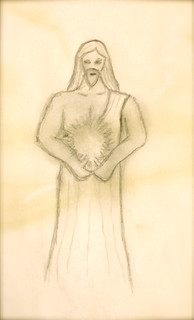
Churches of Olarin are made from stone of light tones. Floorplans tend to be octagonal. Roofs are domed and tiled blue. Walls are lined with tall stained glass windows that let in much light. Alters are topped by the holy devise of a Golden Sun Disc.
Clerics of Olarin wear white robes trimmed with gold cord over golden-brown garments. The best armour worn is chainmail with shield. The sacred weapons wielded are mace (representing the fixed position of the Sun in the Universe) and rod (representing Midday).
Urala
Lady of Night
Urala is the goddess of darkness, coldness, despair, suspicion and vengeance. She is depicted as a tall woman of indeterminate age with dark eyes, semi-long dark hair, pale skin, a black lace dress adorned with stars and a white crescent-moon pendant. She resides in the Netherworld. Her followers include the White Dragon, Air Genie, Succubi & Incubi.
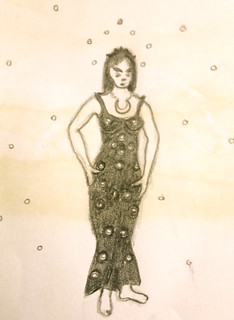
Churches of Urala are made from stone of dark or dull tones. A long hallway will connect two separate circular chambers - one is in permanent darkness and includes a depiction of stars on its domed ceiling while the other is an open courtyard only visited at night. Walls are lined with shadowy alcoves and dark drapes. Alters are topped by the holy devise of a Silver Tear.
Clerics of Urala wear black robes trimmed with silver cord over off-white garments. The best armour worn is chainmail with shield. The sacred weapons wielded are flail (representing the circling of the Moon) and rod (representing Midnight).
Kandoth
Master of Storms
Kandoth is the god of rain, hail, fog, thunder, lightning and anger. He is depicted as a young man of pronounced musculature with blue eyes, wild dark hair and beard, pale skin, grey cloak and an iron spear coursing with electricity. He resides in The Netherworld. His followers include the Iron Dragon and the Gargola.
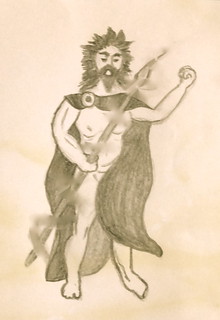
Churches of Kandoth are made from grey stone of jagged and bulging forms on which gargoyles are carved which spew rainwater during storms. Walkways and chambers enclose an open courtyard. A bell tower is topped by iron vanes that hope to attract lightning.
Clerics of Kandoth wear grey tunics and blue hose or skirts. The best armour worn is chainmail. The sacred weapons wielded are spear (representing lightning) and stone sling (representing hail).
Nitara
Mistress of Growth
Nitara is the goddess of plants, animals, habitats, agriculture, fertility and tenderness. She is depicted as a young woman with alluring curves, green eyes, long wavy honey-toned hair, ruddy skin, a rustic green dress, yellow flowers in her hair and a wooden bow. She resides in Paradise. Her followers include the Green Dragon and the Faun.

Churches of Nitara are wooden stockades enclosing a garden with both decorative and food-growing yards. A cabin for the cleric at one end is linked by pergola to a pavilion at the other end for worshippers.
Clerics of Nitara wear green tunics and brown hose or skirts. The best armour worn is chainmail. The sacred weapons wielded are bow-and-arrow (representing hunting) and sickle (representing gathering).
Teloch
Master of Warfare
Teloch is the god of war, combat, skill-at-arms, strategy and competition. He is depicted as a tall athletic man with brown eyes, semi-shaven scalp and face, tanned skin, black studded leather tunic, red wrist and ankle bands and a large steel battle axe. He resides in Discord. His followers include the Red Dragon and the Discordians.
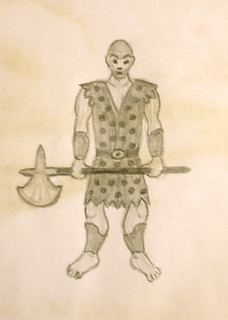
Churches of Teloch are in effect barracks in which itinerant warriors may stay and have the trappings of small fortresses. There is a chamber for worshipping but also a yard in which combat skills may be honed. Alters are topped by the holy devise of a Dented Helm.
Clerics of Teloch wear black tunics and red hose or skirts. The best armour worn is banded mail and shield. The sacred weapons wielded are the battle axe and the hand axe.
Bernali
Mistress of Law
Bernali is the goddess of justice, truth, contracts, law-making and enforcement. She is depicted as a tall athletic woman with grey eyes, braided brown hair, tanned skin, long white dress, silver chainmail tunic and a steel sword. She resides in Harmony. Her followers include the Silver Dragon and the Harmonians.
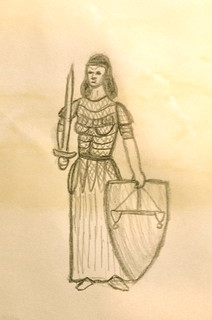
Churches of Bernali serve as colleges for lawyers and are fronted with pillars and wide steps. Inside there are chambers for worship but also for debating implications of laws. Alters are topped by the holy devise of the Balancing Scales.
Clerics of Bernali wear white tunics and silver-grey hose or skirts. The best armour worn is banded mail and shield. The sacred weapons wielded are the long and short swords.
Elchemar
Master of Artifice
Elchemar is the god of crafts, masonry, smithing, construction and invention. He is depicted as a young man with brown eyes and hair, ruddy skin, blacksmithing apron and workaday clothes. He resides in Harmony. His followers include the Black Dragon and the Harmonians.
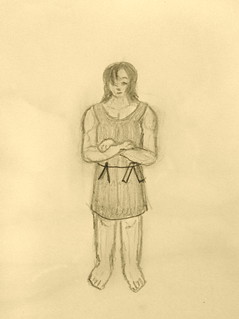
Churches of Elchemar are rambling low-slung constructions that would be mistaken for warehouses or guild houses but for the use of experimental shapes and materials. There are workshops in which artisans may gather and share a passion for crafts. Alters are topped by the holy devise of the Set-Square and Hammer.
Clerics of Elchamar wear beige tunics and black hose or skirts. The best armour worn is chain mail and shield. The sacred weapons wielded are the war hammer and military pick (both adapted from tools).
Linesa
Mistress of Culture
Linesa is the goddess of art, poetry, music, dancing and festivity. She is depicted as a young woman with mismatched eye colours, curly hair, freckled skin, a brass harp and clothes and jewellery of ever-changing colour and design. She resides in Discord. Her followers include the Violet Dragon and the Discordians.
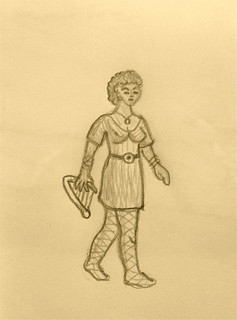
Churches of Linesa are designed to be halls in which art and music can be displayed and performed. They may take the form of an amphitheatre or other structure of such function. A tavern is usually attached. Alters are topped by the holy devise of the Harp.
Clerics of Linesa wear clothes of varying colours and designs with a tendency to clash (purple with green and orange for instance) . The best armour worn is chain mail and shield. The sacred weapons wielded are cudgel and darts (both utilised in a tavern setting).
The Deliverer
Bringer of Rest
The Deliverer holds sway over rest, death, aging, resilience, heritage and genealogy. Is perceived as a nondescript person of indeterminate age and gender (can vary depending on what most comforts the dying witness) with grey eyes, semi-long silver hair, wan skin, fine features, grey tunic and hose, long grey coat. Sometimes can also appear as the traditional cloaked skeletal figure but only to those who are denying the death they must face. Resides in the Eternal Halls and is served by Ghosts.
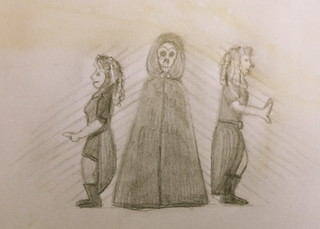
Churches of the Deliverer are small halls of stone and timber of rectangular floor plan. At the front is an entrance over which hangs the holy device of an hourglass. At the back is lectern or pulpit. Behind that is a semi-circular bay in which alters to the other gods and goddesses are arrayed. The yard of the church holds the local tombstones.
Clerics of the Deliverer wear garments of grey. The best armour worn is chainmail and shield. The sacred weapons wielded are staff and walking stick (representing wisdom and age respectively). Members of The Tay (a chapter dedicated to guarding important tombs and relics) also shave scalps and faces, don skull-like masks, wear cloaks and wield scythes.

Religious Rites
Most of the churches have weekly gatherings and seasonal holidays as described here.
They also have responsibility for conducting funerary rites and other life events. Some fulfill this role independently while others do so in conjunction with the Church of the Deliverer. In significant urban areas the civic authority may regulate matters or own funerary land. And the nobility tend to maintain private tombs.
A number of methods of corpse disposal are practiced and vary with culture and practical considerations. These include cremation, burial, immersion and exposure (which each theologically corresponding to the primeval elements of fire, earth, water and air respectively). The intention is to allow for destruction of the corpse and so methods of preservation are eschewed. This minimizes the risk of some forms of Undeath and emphasizes a return to nature. Clerics of the Deliverer are particularly keen on curbing Undeath and Necromancy.
However, important or self-important persons do engage in mummification because this allows for the possibility of resurrection (motivated by greed for life) or revenance (motivated by a desire for revenge).
During funerary and other rites offerings are made to gods and goddesses. These usually take the form of foodstuffs and can include animal sacrifice (followed which those assembled cook and consume the offering). The practice of human or demi-human sacrifice was abandoned millennia ago (except in the case of some demonic cults).
Heresy
Any scholarly effort to put religious tales into a worldly context risks accusations of heresy (from which only some temporal rulers offer defense). One speculation of historians is that gods and goddesses have specific cultural origins. They say that The Deliverer, Bernali, Teloch, Linesa and Elchemar were originally known only in the Empire of Nerina. In contrast Garlomen, Marumi, Olarin, Urala, Kandoth and Nitara have been worshipped far-and-wide for much longer. Note that it is the age of an awareness of these beings rather than the age of the beings themselves that is under discussion. It is by such careful wording that scholars can escape charges of heresy.
A potential heresy is the tale of Twilight. It talks of a 'child of the day and night' who defends the world from 'monsters from beyond the stars' by turning into an obscuring cloud. The monsters pass by in ignorance of a fragile world. However the young Twilight lacks the skill to reverse transformation and thus has committed an act of self-sacrifice. The 'day and night' are left feeling forever barren and listless. As a bedtime story this is hardly controversial. But some say it is evidence of an older truth with grand implications. Surely they say the day and night are indeed Olarin & Urala and that nameless Twilight is a lost and forgotten divinity. It is in this occasionally whispered form that the tale becomes heretical.
Other convictions are always deemed heretical. Some rulers of Imperial Nerina were worshipped as divine (rather than just divinely sanctioned). A handful of cults persist in praying to one or another past emperor or empress but the aristocracy of Nerina enforce severe punishments for these practices if discovered. In response the cults resurface from time-to-time in the clandestine form of philanthropic or self-help fellowships with a philosophic bent. Current suspects of such deception are the recently emerged Ilk and Occult movements.
Most heretical stances stay marginal. The Scrolls of Eternity however are one instance of a heresy that has become commonly accepted.
Scrolls of Eternity
What follows is an excerpt from the Scrolls of Eternity concerning the origins of the universe and its divine rulers. These scrolls were written in 1000CA by the eccentric Rolanian sage known in her writings only by the assumed name 'Perceptisha'. This writer took all the oral and written traditions of the many different churches along with mage-penned cosmology and blended them together into one document telling the story of how the world was made by the gods and goddesses. Anything contradictory was omitted so that one consistent story was told. Perceptisha was instantly demonized by many clerics from all churches but her work became popular nonetheless. Perceptisha was the target of many attempts on her life yet lived to the ripe old age of 101. Some see this fact as ratifying the accuracy of her version of the story of creation.
Others however continue to tell different tales. The Zinda for instance say that Olarin and Urala (Papa Larin & Mama Rala) did become estranged but have since reconciled. Similarly the Druids say that they were never estranged but simply must work apart and come together at Dusk and Dawn. Furthermore they say that The Deliverer is the loyal servant and agent of Garlomen & Marumi.
The Making
In the furthest forgotten past there was an eternity of moments in a moment of eternity. In that most distant past The Lands were as nothing and the nothingness extended forever. All was empty. All was still. All was uniform or so it seemed to the four beings that came wandering into this time and space of nothingness. Those four were natives of the elemental realms that are at once utterly divorced from the world and yet utterly entwined with it. As they came straying into this realm of nothingness all they noticed was the absence of things. The realms from which they came contort and flow with substance and power and as such they overlooked the shadows and echoes that even then filled the seeming nothingness.
Olarin came from the Realm of Fire. His heart and mind burned with a desire to discover new things and revelled in the finding of this realm even if it were a world of seeming nothingness.
Urala came from the Realm of Air. Her heart was timid yet her mind was intrigued by this new realm into which she had strayed. She wandered silently marvelling at the emptiness.
Marumi came from the Realm of Water. She felt there must be something here and hunted long in the vacant expanse. She wandered this way then that way and never stuck to one direction for long.
Garlomen came from the Realm of Earth. He felt that the emptiness was there to be filled and decided to start by settling in it himself. So he stopped and began to make an encampment.
In the emptiness two of these beings met – Olarin and Urala. She could see and hear him coming from some distance burning and blazing as was his wont. He however only sensed her the moment he passed her hiding still and silent. She felt sudden warmth fill her. He felt his flame expanding into his surrounds. From that moment a wild love formed between the two that threatened to meld them together so that any form of self was lost forever. Urala had never felt anything like it and was prepared to surrender to it. Olarin however craved his self still and resisted the melding by collapsing into himself and becoming as a sphere of vibrant light. Urala expanded to fill the space in which Olarin sat so that she may envelop him and feel his warmth still.
In the distance both Garlomen and Marumi witnessed the radiance of Olarin softened by the light-filled haze of Urala. Both made for the new something in the infinite nothingness. On the way there Garlomen and Marumi met. They conversed. They considered the nature of this newly discovered realm and how they may have a role in it. As they talked a love grew between them milder than that of Olarin and Urala yet more at one with the ways of eternity. Slowly Garlomen and Marumi were entwined. As seas enclose islands so Marumi embraced Garlomen. As hills surround a lake so Garlomen held Marumi.
Thus the contours of the world as we know it began with fire in the sky and with lands among the seas. The four creators of The Lands walked together and at other times apart. Garlomen & Marumi were always close at hand but Olarin & Urala were frequently parted. Olarin was happy in spending time with Urala but was also content to wander alone. Urala felt differently. She had once known and accepted loneliness but now she knew and craved only the company of her beloved Olarin. So to placate her Olarin gave Urala the gift of stars so that she may enjoy his light even while he was away. While they were together it was day. While they were apart Olarin was as a solitary sun in an eternity of darkness and Urala was as a night sky filled with stars.
In time children came into the lives of the elder powers. Then Garlomen & Marumi had twin progeny - a boy and a girl. These two were of the same nature as their parents and yet they were also intimately attuned to the world into which they were born.
The son was named Kandoth and revelled in playing with the raw substances with which his elders had filled the world. Kandoth understood that in this world the four elements combined in infinite ways and he experimented with relish at producing new substances - mud, fog, smoke, ash, dust and fume were his play-things. Of all his works the ones that filled him with the greatest excitement were lightning and thunder.
The daughter was named Nitara and was of a more careful and observant nature. She wandered far and wide simply looking and listening and feeling the things that were in the world. It was in this way that Nitara noticed the shadows and echoes that had always existed but had been overlooked by her elders. They were elusive however and she desired to capture them to better understand them.
Nitara and Kandoth began experimenting with forming vessels in which they may snare the shadows and echoes. For long they worked in making objects to hold their ephemeral quarry. Nitara contributed to the task her ability to sense and attract the shadows and echoes. Kandoth contributed to the task his skill with blending the elements. Nothing seemed to work so they made the vessels of more complex and intricate form and composition so that eventually they devised something into which the shadows and echoes would stay for a while. It was then that Nitara noticed that the shadows and echoes changed the objects into which she put them. They had the ability to grow and alter to better fit the world. And yet Kandoth knew that the vessels they inhabited were fragile because of the complex blend of elements. Thus the time in which a vessel was inhabited was short. However another thing they noticed was how inhabited vessels produced new vessels into which shadows and echoes instantly entered. Life originated with these progenitors and some say that those original specimens exist today as relics that can assume both crafted and living states at a whim.
While some living vessels would stay still in slumber others would move and interact. Thus did the plants and animals come into the world. The shadows and echoes are what scholars now call 'Animus' and it is this ingredient that gives life to substance. The dormant Animus gives plants life while the active Animus gives animals life. Nitara loved and doted on life and tended to it so that it flourished and began covering the world. Kandoth loved to test and taunt life which only helped to scatter it across the world and make it more accustomed to the wild nature of the elements. Siblings always vex one another and it was over the plants and animals that Nitara and Kandoth bickered and became estranged.
Betrayal & Exile
As babes Kandoth and Nitara had spent much time with Garlomen & Marumi as is right for the children of parents. But as they grew to maturity they spent more time alone or just with one another. Now they had bickered and wanted to be apart. Kandoth played with the elements as was his sport. Nitara danced in the wild gardens of life. But both were lonely and in time came to keep the company of the other two elders. Kandoth was drawn to Urala whose cool reserve calmed him. Nitara was drawn to Olarin whose bold joy thrilled her. These meetings became more frequent while Olarin & Urala were parted. And over time the partings of Olarin & Urala became longer and longer. Kandoth would amuse Urala with storms to fill the still night. On day-long walks Nitara would show Olarin the plants and animals and talk long on the names and nature of these things. At first these relations were innocent but then furtive passion grew from the seeds of longing and neglect.
Urala flirted coyly but Kandoth seemed ignorant of her ways. Urala decided to force matters by making the air colder and colder but all this did was to make Kandoth pull his cloak of cloud closer to himself. Olarin too was tantalized by Nitara and one day made it so hot that Nitara removed all her garlands of vines and grass and once this was done he moved to seduce her. And yet Olarin & Urala had an affinity which transcended immense distances and thus the ecstasy felt by Oralin was also felt by Urala. The betrayed spouse rushed to find her betrayers.
On a sunlit grassy hillside, filled with flowers and bees, Urala witnessed the carnal arts of Olarin and Nitara and was filled with a cold emptiness that turned to chill hate. She stood motionless and shed but one tear of ice. Kandoth had followed her and drew to her side. On seeing her condition, and then the writhing ardour of Olarin and Nitara, he flew into a rage and interrupted the lovers. As soon as Olarin and Nitara were once more aware of the world beyond themselves, they were filled with shock and remorse. This only seemed to enrage Kandoth further, and he rushed at them wielding his iron spear. Olarin rose to meet the onslaught open handed and did his best to overpower the wild Kandoth. Nitara stood by in a state of distress. She loved both Olarin and her sibling Kandoth, but she feared that the armed Kandoth would harm Olarin, and in desperation drew forth her bow and fired arrows at Kandoth. Kandoth was distracted by the volley which gave Olarin the chance to disarm Kandoth and throw the spear aside. Now however, the stationary Urala entered into the fray, lifting the spear and advancing behind Olarin. Once more Nitara loosed arrows, this time at Urala, who then turned to face her attacker, spitting frost and hateful words as she did.
The rumour of this violent clash reverberated to the far ends of the world and drew the attention of Garlomen & Marumi. They were appalled at what they discovered and demanded instant cessation of hostile acts. This they were granted. They then demanded to know what the cause of it all was. Kandoth told of the infidelity of Olarin with Nitara. Olarin admitted his fault and asked Urala to forgive him for his rash and impulsive act. Urala swore that she would never forgive him and would divide the world between them so that one half would have eternal night while the other would have eternal day. Nitara simply knelt there weeping onto the grass. Garlomen & Marumi noted all this and then declared with one voice that the other four had broken the balance of the world and must be prevented from tarnishing it further with acts of division.
Garlomen & Marumi were of united purpose while the others were all wanting different things which shifted with every argument spoken and every passion expressed. This made Garlomen & Marumi powerful at that moment. They gave the others an ultimatum - all intimacy other than that of Olarin & Urala must cease and all hostility must be put behind them. The consequence for anyone defying this would be banishment from the world. Nobody could agree to all of this and as a result four were exiled by two. As they left the world they were instructed to hand over to Garlomen & Marumi much of the power they had over aspects of the world they had shaped. As such Garlomen & Marumi now had day-to-day control of all the aspects the world.
Paradise & The Netherworld
Olarin left the world to find a realm for himself in which to contemplate the error or his ways and find peace in his heart. However Nitara followed him at a distance. Olarin came to a vacant realm at the very end of existence and non-existence. It became a realm of eternal and infinite daytime sky with the Sun at its core. Encircling this were endless clusters of white clouds and every cloud was an island on which immortals may walk. On some cloud-islands Oralin wandered or sat and pondered and golden pavements and marble arches formed from his contemplations. On other cloud-islands however Nitara strayed and the top surface of these was covered with teeming life to which she tended. On discovering her presence Olarin was welcoming to Nitara but also reserved. Nitara accepted this distance between them and focused on her work with the growth and fertility of living forms. This realm is known to mortals as Paradise.
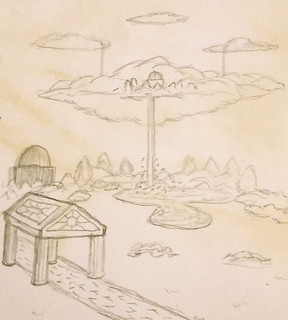
Urala left the world to find a realm for herself in which to brood eternally over the injury and insult she had suffered. Kandoth followed her and together they came to a vacant realm at the very ends of existence and non-existence. It became a realm of eternal and infinite night. In its frost-tarnished and starlit wastes Urala dwelt. Over its storm cloud covered and ragged plateaus Kandoth wandered. At times they lived alone and Kandoth was satisfied with twisting and deforming the plateaus with his storms in endless variation. At other times however Urala summoned Kandoth to her obsidian mansions and they would rend and kneed one another in desperate abandon. For Kandoth these liaisons were simply for the sating of desire. For Urala however they were futile acts of vengeance on those at another end of the universe. This realm is known to mortals as The Netherworld.

The exiled immortals had had a hand in the shaping of the world and as such were still connected to those aspects over which they had ruled. Those realms emanate into this one. The Sun that shines eternally in the realm of Olarin shines also into this world during the day. The stars that coldly shimmer over the realm of Urala also fill the night of this world. The densest concentrations of life in this world are also a part of the realm of Nitara. The wildest storms of this world also brew in the realm of Kandoth. While these realms are distant they are also woven together with every aspect they have in common. But in this world the power of the Exiled is limited by the diluting power of Garlomen & Marumi who exist within it and across it and under and over it still.
The Strangers
Garlomen and Marumi would work long and hard to manage the world and would then retire together to a modest dwelling. They were comforted by the company each gave the other and yet they also secretly desired more company than they now had.
One misty evening Marumi was at the well drawing water when she felt a shiver and saw a shrouded figure watching her from a safe distance. By the time she had summoned Garlomen to see, the figure had gone, and Garlomen dismissed it as merely the imagination of his over-tired spouse. However, the next morning, Garlomen was digging furrows in the garden in which to plant seeds, and he too saw a shrouded figure watching him from afar. This time it was Garlomen who summoned Marumi, and this time it was Marumi who came too late to see the elusive form, but she believed her spouse, as she had seen it herself the night before.
That day both Garlomen & Marumi were too busy to ponder the apparition over-much, but in the evening they were visited, this time by five cloaked and hooded figures who came right to the front door. Garlomen & Marumi met with these strangers and asked them to introduce themselves. It was at this that the central of the five figures stepped forward and spoke.
The five figures were immortals much like Garlomen & Marumi. They were looking for a world to call home. They had taken a liking to The Lands and wished to have permission to live in it. More importantly they knew a secret that would make the world change and grow to its fullest and best - a secret they were prepared to share if they could become part of it. Garlomen & Marumi were wary yet curious. The speaker told them of the secret:
The shadows and echoes that filled The Lands had always been there and were now populating the world as plants and animals. But some of the shadows and echoes were newer than the world and were themselves the emanations of the gods and goddesses that had shaped The Lands. Every movement of Olarin, Urala, Kandoth, Nitara, Garlomen & Marumi had cast further shadows and echoes into the world and they were eternal and divine just as those who had inadvertently produced them.
The speaker went onto say that the native shadows and echoes of The Lands were the Animus that gave plants and animals temporary life but that the divine emanations would give them life eternal. These fragments of Spirit could be attached to wakeful Animus and change animals into new and wondrous beings that would go onto make The Lands a truly spectacular world of never-ending change.
Garlomen & Marumi were fascinated and asked many questions. They were told that the quantity of Spirit was numerous yet limited in comparison with Animus and that only some animals would ever be imbued with such Spirit. They were told that the personality invested into the Spirit by experiencing a mortal life was then as immortal as the Spirit itself. They were promised that over time the gods and goddesses would be attended by an ever-growing community of eternal companions.
Garlomen & Marumi then asked why the strangers wanted to do all this. The answer came from the speaker - they craved a world of variety and change. They desired companions beyond the handful they knew. They wished for a world in which to share all these things. And they desired to rule over aspects of such a world. It was then that the four other visitors threw away the cloaks that had hid them. The speaker stayed shrouded but introduced the other four each in turn.
Bernali was a statuesque woman who desired to instruct the new living spirits in how to live together in peace and harmony. She would become Goddess of Law.
Teloch was a lean man who desired to show the new living spirits how to fight in those times that peace elluded them. He would become God of War.
Linesa was a petite woman who desired to show the new living spirits how to live together and sing and play and fill the nights with music. She would become Goddess of Culture.
Elchemar was a wiry man who desired to instruct the new living spirits in how to take raw substances and form them into tools with which to fill the days with work. He would become the God of Artifice.
Finally the speaker was offered as the one who would gather spirits that had detached from living forms and deliver them to whichever god or goddess was best suited to offer them shelter and guidance.
All of this excited Garlomen & Marumi but they needed time to think so they asked for another meeting the following evening. To this the speaker - now known as the Deliverer - and the other four agreed. That night Garlomen & Marumi discussed the world-changing proposition. They wanted what was offered but they still wanted the world to be as they had shaped it. Garlomen declared that together they held sway over the eternal forces of nature and that the temporary lives of those to be created must never surpass those forces. Marumi observed that the five strangers all had a common purpose but all had divergent desires and that only the careful words of the Deliverer held them together. With that in mind she proposed that the Deliverer be befriended over the others.
The next evening the five visitors met the two residents of The Lands. Garlomen & Marumi indicated that they would welcome the visitors and engage in the cause of investing life with spirit as long as some conditions were met. One condition was that they be present at the moment that every new vessel was invested with spirit. Another was that the visitors must maintain abodes beyond the world, that only Garlomen & Marumi would maintain a habitation in The Lands, and that they would welcome the visitors to their home, expanding it so that each visitor had a wing to themselves. Four of the visitors looked set to protest such demands but the Deliverer declared the offer more than generous and persuaded the others to agree. Garlomen & Marumi - united as always - invited the others to dine with them and to discuss the coming project. The seven so gathered all ate well and drank too much that night.
The hosts observed the interactions of their guests. Teloch and Elchemar only conversed together on the topic of perfecting arms and tactics. Bernali and Linesa only conversed together on the topic of how custom and decree affect one another. Bernali and Elchemar conversed frequently and seemed to have a relaxed and well-practiced relation. Teloch and Linesa switched rapidly from bickering to jesting and this seemed to be how they preferred relating. As the wine flowed the hosts noticed that Teloch and Bernali had a tense argument over just how much aggression could be curbed in life. Likewise they noticed that Elchemar was annoyed by the way in which Linesa would tease him. They also observed that The Deliverer could end any altercation with just a softly spoken word or a sidelong glance. Afterwards in private Garlomen & Marumi themselves had an argument as to the nature of The Deliverer - Garlomen insisted on a feminine visage but Marumi was sure of seeing a masculine face.
The Birth
The next morning they all rose to begin the work of making the men and women of The Lands. Garlomen and Marumi took the others to a remote valley which they felt was the safest locale for new life to begin. They summoned to them a few dozen animals of inquisitive and gregarious temperament. The Deliverer put them all to sleep. The Deliverer then showed the others how to find and capture fragments of Spirit and how to cast them into the animals. At once Spirit would bond with the Animus and changes would be observed in the form of the body.
The first dozen enspirited forms rose and were so amazed by the world they experienced that they overlooked the gods and goddesses among them. Or if they did notice the creators it was only to assume that they were peers. They rushed with glee into the meadows and forests of The Lands to find paths for themselves. The descendents of these flawed creations became the Elves of today.
The second dozen enspirited forms changed but continued to slumber. The visitors became impatient and so the Deliverer began work on the next dozen and set the sleepers aside in a safe gully. The sleepers persisted in sleeping and did so till the gods and goddesses departed and night fell. On waking the sleepers assumed that they had always been that way and went wandering into the hills and dells. The descendents of these flawed creations became the Dwarves of today.
The third dozen enspirited forms rose and responded to the presence of the gods and goddesses with fear and anger. They snarled and scratched more fiercely than they ever had as animals. They ran into the caves and catacombs that dotted the valley and hid away from the light. The descendents of these flawed creations became the Orcs of today.
The Deliverer went on like this till finally an enspirited form was produced which stayed and harkened to the words of the gods and goddesses. It was these satisfactory creations that became Humanity and it is only Humans who truly follow the purposes intended for them.
Humanity has since followed the guidance of the gods and goddesses and formed bonds of loyalty with all of them - whether they are resident in the world or vistors or even with the exiles who still hold sway over aspects of The Lands.
And since the immortals had helped make mortals they then needed to rest just as mortals do. As such the visitors went to vacant realms at the very ends of all the many realms upon realms of existence and non-existence to find new homes that are nonetheless woven together with the world in which we live our lives.
Harmony & Discord
Bernali and Elchemar decided to both dwell in what became Harmony. In it cogs and wheels the size of islands turn in intricate patterns across an eternal sky. Every wheel is a citadel dedicated to precision and predictability. Every wheel has a 'top-side' of silvery day and a 'bottom-side' of black lamp-lit night. Rules and regulations govern everything - even the pulses of those who reside there. Artifice develops in many a workshop and laboratory according to strict experimental procedures.
The Harmonians debate laws which only Bernali can ratify. Likewise they develop new skills of craft solely arising from the inspirational directives of Elchemar. Only in The Lands can mortals dictate such things for themselves. In Harmony everyone is content because that is the temperament that realm imbues in them. Every Harmonian has a precise rank and role and all tasks are done as they march the streets of steel and glass and etched stone.

Teloch and Linesa decided to both dwell in what became Discord. It is an inverted world in which inhabitants walk on the inner surfaces of a twisting and ever-changing array of gigantic tunnels and chambers. The tunnels are a wilderness of capricious climate and habitat. They intersect at chambers that are like provinces ruled over by tiny suns or moons that hang in the centre of those chambers and determine whether it is permanent day or eternal night. Every inhabitant can seek its own fate and over days whole nations can gather and scatter with the whims of those who comprise them.
The Discordians fight with one another for whatever cause or passion drives them. Likewise they sing new songs and tell new tales at a whim and customs are changed as quickly as garments. The will of even one Discordian can alter the way in which the realm in its vicinity behaves - Discord is a world made of the moods of its inhabitants. Teloch and Linesa are simply the best there at setting or shifting a trend and do so with gusto.

The Eternal Hall & The Shadowlands
The Deliverer needed a home in which to both work and rest and that realm more than any other realm sits between and allows access to all realms. The spirits of The Lands pass into The Eternal Hall of The Deliverer on the way to serving whichever god or goddess has claimed them. The Eternal Hall runs parallel to every moment in history. For the visitor it seems to be a misty nothingness till one looks for a while in a particular direction and sees shaded walkways and gardens emerging from the greyness like a drawing that slowly takes on shades and forms. There are many benches on which to rest and many arches accessing other realms. It is a calm setting yet also a pensive one which instills in its visitors a sense that they must be moving on.

The Deliverer visits The Lands more than the other visitors and yet Garlomen & Marumi only meet with that guardian of spirits sporadically. Garlomen & Marumi decided that they - like the others - needed to be connected to and yet distinct from the world. And as all of existence is an infinite multitude of shades and hues so they shifted their home to be only minutely removed from that of mortals. The Shadowlands are a hazy reflection of The Lands from all eras and none in which spirits carry on much as they did in life and tend to everyday chores and tasks - hunting and fishing and farming. However some say they must enter by crossing a wide river then climbing steeply to a temperate plateau.

And so The Lands and the habitations of the divine are intertwined in never-ending twists and turns. An eternity of moments in a moment of eternity confines us still and yet now the world which the gods and goddesses scrutinize is one of dazzling colour and movement from which the stillness and emptiness have been vanquished. And yet the shadows and echoes waft among us as always.


<< Home